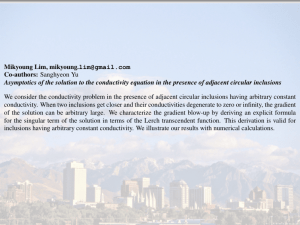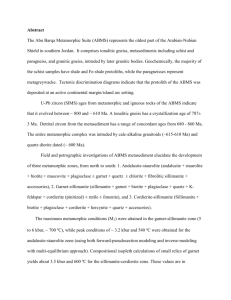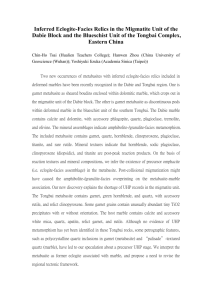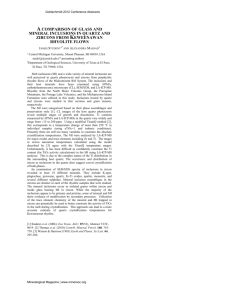Inclusion patterns in zoned garnets from
advertisement
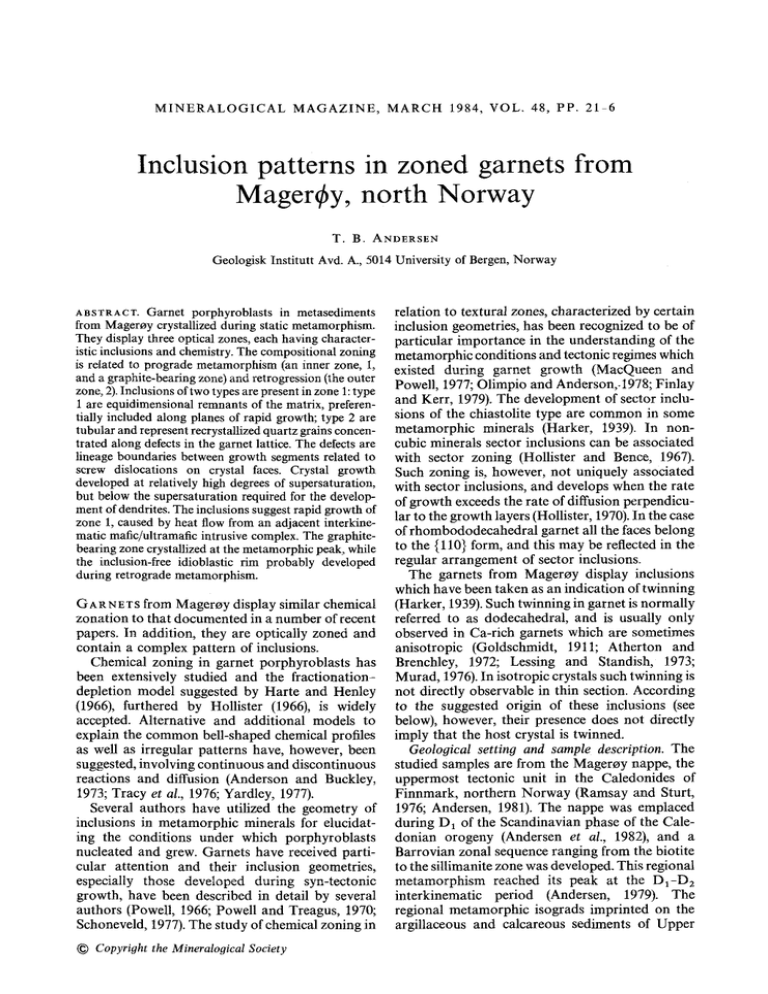
M I N E R A L O G I C A L M A G A Z I N E , MARCH 1984, VOL. 48, PP. 21 6
Inclusion patterns in zoned garnets from
Mager by, north Norway
T. B. ANDERSEN
Geologisk Institutt Avd. A., 5014 University of Bergen, Norway
ABSTRACT. Garnet porphyroblasts in metasediments
from Mageroy crystallized during static metamorphism.
They display three optical zones, each having characteristic inclusions and chemistry. The compositional zoning
is related to prograde metamorphism (an inner zone, 1,
and a graphite-bearing zone) and retrogression (the outer
zone, 2). Inclusions of two types are present in zone 1: type
1 are equidimensional remnants of the matrix, preferentially included along planes of rapid growth; type 2 are
tubular and represent recrystallized quartz grains concentrated along defects in the garnet lattice. The defects are
lineage boundaries between growth segments related to
screw dislocations on crystal faces. Crystal growth
developed at relatively high degrees of supersaturation,
but below the supersaturation required for the development of dendrites. The inclusions suggest rapid growth of
zone 1, caused by heat flow from an adjacent interkinematic mafic/ultramafic intrusive complex. The graphitebearing zone crystallized at the metamorphic peak, while
the inclusion-free idioblasfic rim probably developed
during retrograde metamorphism.
G AR N ETS from Mageroy display similar chemical
zonation to that documented in a number of recent
papers. In addition, they are optically zoned and
contain a complex pattern of inclusions.
Chemical zoning in garnet porphyroblasts has
been extensively studied and the fractionationdepletion model suggested by Harte and Henley
(1966), furthered by Hollister (1966), is widely
accepted. Alternative and additional models to
explain the common bell-shaped chemical profiles
as well as irregular patterns have, however, been
suggested, involving continuous and discontinuous
reactions and diffusion (Anderson and Buckley,
1973; Tracy et al., 1976; Yardley, 1977).
Several authors have utilized the geometry of
inclusions in metamorphic minerals for elucidating the conditions under which porphyroblasts
nucleated and grew. Garnets have received particular attention and their inclusion geometries,
especially those developed during syn-tectonic
growth, have been described in detail by several
authors (Powell, 1966; Powell and Treagus, 1970;
Schoneveld, 1977). The study of chemical zoning in
~) Copyright the Mineralogical Society
relation to textural zones, characterized by certain
inclusion geometries, has been recognized to be of
particular importance in the understanding of the
metamorphic conditions and tectonic regimes which
existed during garnet growth (MacQueen and
Powell, 1977; Olimpio and Anderson,-1978; Finlay
and Kerr, 1979). The development of sector inclusions of the chiastolite type are common in some
metamorphic minerals (Harker, 1939). In noncubic minerals sector inclusions can be associated
with sector zoning (Hollister and Bence, 1967).
Such zoning is, however, not uniquely associated
with sector inclusions, and develops when the rate
of growth exceeds the rate of diffusion perpendicular to the growth layers (Hollister, 1970). In the case
of rhombododecahedral garnet all the faces belong
to the {110} form, and this may be reflected in the
regular arrangement of sector inclusions.
The garnets from Mageroy display inclusions
which have been taken as an indication of twinning
(Harker, 1939). Such twinning in garnet is normally
referred to as dodecahedral, and is usually only
observed in Ca-rich garnets which are sometimes
anisotropic (Goldschmidt, 1911; Atherton and
Brenchley, 1972; Lessing and Standish, 1973;
Murad, 1976). In isotropic crystals such twinning is
not directly observable in thin section. According
to the suggested origin of these inclusions (see
below), however, their presence does not directly
imply that the host crystal is twinned.
Geological setting and sample description. The
studied samples are from the Mageroy nappe, the
uppermost tectonic unit in the Caledonides of
Finnmark, northern Norway (Ramsay and Sturt,
1976; Andersen, 1981). The nappe was emplaced
during D1 of the Scandinavian phase of the Caledonian orogeny (Andersen et al., 1982), and a
Barrovian zonal sequence ranging from the biotite
to the sillimanite zone was developed. This regional
metamorphism reached its peak at the D1-D 2
interkinematic period (Andersen, 1979). The
regional metamorphic isograds imprinted on the
argillaceous and calcareous sediments of Upper
22
T. B. A N D E R S E N
Ordovician-Lower Silurian age are modified
around a syntectonic mafic/ultramafic complex
intruded at the time of the regional-metamorphic
maximum (fig. 1). No detailed study of the contact
metamorphic aureole has yet been carried out.
~
L
LEGEND
SKARSV~GNAPPE
MAGERdpYNAPPE
SI~
+~++ Metasediments
-"
ContactmetQmorphicaureole
Ky ~
Granitic int~siv~
Mafic/uhramaflc [ntruslves
Si'"
-
~N
FINMARK
C
A
IO
N
MPLEX
Staurolite
isograd
Kyanite
isogmd
S[lli~nite
[sograd
FIG. 1. Simplified geological and metamorphic map of
Mageroy.
The configuration of the regional metamorphic
zones developed during the interkinematic interval
and the trend of the isograds (fig. 1) was only
slightly modified by folding during D2. Growth of
syn-tectonic D 1 garnets were confined to the area
north-west of the present (inter D~-D2) staurolite
isograd (Andersen 1979). Everywhere within the
north-western part of Mageroy, where garnets
preserve inclusion fabrics, the cores of the porphyroblasts contain syn-tectonic inclusion patterns
and the margins overgrow the S ~ schistosity (fig. 2).
The garnets described here were collected from
an area which lies in direct continuation with
the regional kyanite zone adjacent to one of the
interkinematic mafic/ultramafic bodies of the
Mageroy igneous complex. The mineralogy of the
sampled locality is identical to that of the regional
metamorphic paragenesis of the kyanite zone.
Thin sections show biotite, garnet, staurolite, and
kyanite to be major constituents together with
quartz and plagioclase. Muscovite and opaques are
accessories. A relic S 1 schistosity defined by the
orientation of biotite is present, although strongly
modified by recrystallization and neomineralization during the metamorphic maximum. The lack
of syn-D1 garnet at this locality indicates that the
regional metamorphic grade was of low to intermediate greenschist facies during D1. The Tconditions were, however, rapidly adjusted during
the metamorphic maximum at the interkinematic
period to equilibrate with that of the kyanite zone
of western Mageroy. It is likely that this originated
from the heat flow from the developing mafic/ultramafic complex which was intruded at this stage. In
the studied samples idioblastic garnet and staurolite overgrow the early schistosity. The staurolite
displays frequent penetration twinning. Kyanite
nucleated after staurolite and overgrows staurolite
and biotite, a textural relationship commonly observed also in western Mageroy.
Geometry of the inclusions. Inclusion geometries
of two types are present in the garnets (fig. 2a).
These are classified according to their orientation
with respect to the crystallography of the garnet
host.
Type 1 inclusions are concentrated along sectors
which are parallel to the crystallographic planes of
the host garnets defined as containing the line of
intersection between two adjacent crystal faces and
the centre of the garnets. Synoptically they form the
sides of twelve pyramids with common apices at the
centre of the garnet crystals, and bases formed by
the {110} crystal faces. The inclusion-rich planes
represent the traces of the growing crystal edges
(Harker 1939).
Where identification of the transparent inclusions is possible, either optically or by microprobe,
they are found to consist of quartz. Fe Ti oxides
and graphite have been identified amongst the
opaque inclusions, but these are usually to small to
identify. The individual inclusions defining the type
1 pattern are dominantly equidimensional (fig. 2b).
That the inclusions represent relics of the matrix is
suggested by the gradual coarsening of the inclusions towards the margins of the garnets, an
indication of prograde coarsening of the matrix. It
is evident that a mechanism by which the matrix
was preferentially trapped along growing crystal
edges was operating. By a simple geometrical
consideration it can be demonstrated that growth
along crystal edges in a garnet with the form {110}
exceeds growth perpendicular to the crystal faces
by a factor of 1.2. This is on the assumption that the
crystal is a layerite and not a dendrite, and that the
garnet retains its idioblastic habit.
The type 2 inclusions were also described by
Harker (1939, fig. 100). They comprise slender
tubular inclusions of quartz which are not relics of
ZONED
GARNETS
FROM NORWAY
23
FIG. 2(a). Photomicrograph showing garnet porphyroblast sectioned through the centre. Zone 1, the graphite zone, and
zone 2 (rim) are developed, with the inclusions of type 1 and 2 in the inner zone 1. Frame indicates enlarged area shown
in fig. 2d. Scale bar approximately 330/~m. (b) Detail of inclusion patterns I and 2. The vertical train of equidimensional
type I inclusions and the slender quartz tubes of type 2 are shown. Scale bar approximately 15/~m. (c) Oblique section of
garnet porphyroblast showing variation in shape and angle between inclusions of type 1 and 2 as a result of the cuteffect. (d) Detail of fig. 2a showing the transition from zone 1 through the graphite zone to zone 2. The graphite
zone characterized by abundant opaque inclusions fills depressions in the zone 1 surface above the inclusions of type 2.
The type 2 inclusions define lineage boundaries between growth segments in zone. Scale bar approximately 20 #m.
the matrix, but have formed simultaneously with
garnet growth. F r o m different sections t h r o u g h
garnets the s h a p e a n d o r i e n t a t i o n of the inclusions
c a n be accurately determined. They are a r r a n g e d so
t h a t the long axes of the tubes are at 90 ~ to the
crystal faces, a n d m a k e a n angle of 30 ~ with the
planes c o n t a i n i n g inclusions of type 1. In sections
cut parallel to crystal faces they a p p e a r circular a n d
24
T.B.ANDERSEN
become progressively more elongate as the angle
between the crystal face and the section increases
(fig. 2c). Each of the tubular inclusions usually has
uniform extinction, showing that the crystal lattice
is continuous. Rarely inclusions may consist of two
crystals with different crystallographic orientations. Variations in extinction direction from one
inclusion to another indicate a random orientation
of the quartz lattice relative to the garnet lattice.
The absence of preferred lattice orientation of the
quartz inclusions relative to garnet indicates that
the interphase boundaries between quartz and
garnet are non-coherent. The lattice continuity of
quartz, however, shows that new material was
added to the end of the tubular inclusion as the
crystal face of the garnet propagated.
The consistent shape orientation of the tubular
inclusions perpendicular to the {110} crystal faces
shows that they have a similar orientation within
the crystal lattice of the garnet in each of the
pyramidal segments bounded by the planes rich in
the type 1 inclusions.
Chemical zoning. The Mageroy garnets were
analysed with an ARL electron microprobe at the
University of Bergen. They show a symmetrical
chemical zoning related to their internal optical
zones (fig. 3). Zone 1 which contains inclusions of
type 1 and 2 is characterized by a high Mn content
which decreases outwards and is mirrored by
increasing Fe concentration (fig. 3). Ca shows a less
pronounced, but distinct decrease from the core of
the zone 1 to the graphite zone, and this is compensated by an increase in Mg. The graphite zone is
marked by an antipathetic variation of Ca and Fe,
Ca showing either a slight increase or a constant
concentration. The concentration gradients for Mn
and Mg remain almost continuous with those of
zone 1. The inclusion-free zone 2 forming the
idioblastic rim shows an increase in Fe and Mn,
and reduced concentrations of Mg and Ca.
A growth model and the origin of the inclusion
pattern. The Fe and Mn concentrations in zone 1 in
the Mageroy garnets are consistent with the fractionation model (Hollister, 1966). Garnet crystallization probably involved a reaction of the type:
Chlorite + muscovite + quartz --,
garnet + biotite + H 2 0
Mol %
Spessartile
+
17
Mol %
48 P y r o p e
17
0
16
16
15
15
18
1/-"
13-
~b
.13
.12
11-
.11
10-
-10
9-
.9
8-
.8
7-
.7
6-
.6
5-
.5
./,
4-
.3
.
Mol */,
Grossular
o
.17
3Mol %
74A l m a n d i n e 73+
7271-
.15
70-
.15
69-
-14
686766B5-
'~'~'~~'~'~
-13
-12
-11
-I0
64-
-9
63-
-8
52-
.7
-6
6160
::::::::::::::::::::::::
1
5
10
15
20
23
5
I
C~!~~.2..':,
|
i
(1)
As discussed above the timing of deformation and
metamorphism indicate that the increase in metamorphic grade in the locality where the garnets
preserve the type 1 and 2 inclusions was more rapid
than in other areas with kyanite and staurolitebearing metapelites in Mageroy. It is difficult to
explain this very local variation in terms of variation of the regional geothermal gradient. Although
the thermal effects of the igneous complex have not
J'
12-
Diameter
i i a~i
(~ll.~_I
i i I~
NI
t-DI
Zone
1345 microns
I
w
iC',li
21 i
~ ~1
!:l I O l
INI
FIG. 3. Typical compositional profile of garnet from the
studied locality (fig. t). The analysis points (1-23) and the
optical zones are indicated.
Z O N E D GARNETS F R O M NORWAY
been studied in detail it is conceivable that the more
rapid increase in metamorphic grade was caused by
access to heat from the post-D1 mafic/ultramafic
intrusions. It is thus possible that the thermal
gradient around this complex shortly after D 1
became more important in the studied area than the
regional geothermal gradient.
The increase in temperature which initiated a
continuous garnet-forming reaction of type 1, and
the physico-chemical conditions resulting from
this, controlled the growth defects in the crystallizing garnet porphyroblasts which is indicated by the
inclusion pattern. A rapid increase in temperature
would favour the growth of twins in the new
mineral phases since twinned nuclei grow more
rapidly than untwinned with increased supersaturation (Spry, 1969). The inclusion geometry
alone cannot, however, be used as an indication of
twinning, and as the garnet porphyroblasts invariably are isotropic it is unknown if they are
twinned.
For the type 1 inclusion geometry it has been
argued that these are relics of the matrix which were
preferentially included along directions of rapid
growth. This is in agreement with the conclusions
drawn by Harker (1939).
The formation of the type 2 inclusions is considered to be the result of a growth mechanism
where the garnet developed a cellular substructure
(Chalmers, 1964). In this model the crystal faces
advanced as a number of growth pillars. The
development of such growth pillars may originate
from a sheet growth mechanism where the growth
occurred on nuclei formed by screw dislocations on
the crystal faces (Verma and Krishna, 1966). Such
dislocations and growth spirals on the crystal faces
have been observed in synthetic garnets (Lefever
and Chase, 1962). Following Smith's (1963, pp.
57-69) argument and terminology, growth from a
number of screw dislocations on each face is likely
at values of supersaturation below those causing
dendritic growth. According to this mechanism the
crystal face may advance as pillars, forming a
crystal which is a cellular layerite. The present
author will not attempt to relate directly the
concepts of supersaturation and Chalmer's (1964)
summary of the physico-chemical conditions necessary for the development of a cellular substructure
in metallurgical experiments to those of solid state
metamorphic conditions. If, however, the inclusion
pattern of type 2 observed in garnets from Mageroy
is analogous to that of the cellular substructure it
implies an element of 'constitutional superheating'
(analogous to constitutional supercooling in crystallization from a liquid) whereby the T-conditions
for the stability of the reacting minerals in reaction
(1) are exceeded.
25
The junction between the cellular segments or
growth pillars form surfaces with plane defects in
the crystal. Such surfaces are known as lineage
boundaries, and are sites of less order and completeness in the crystal. Lineage boundaries of this
kind form depressions on the crystal faces. In the
present case the tubular quartz inclusions probably
originated in such positions and continued to form
depressions on the crystal faces as long as the
growth took place on growth spirals (fig 2d). The
variations in orientation of the quartz lattice which
formed along the lineage boundaries may have
been controlled by seeds of matrix quartz, or by
random nucleation. Diffusion along lineage
boundaries would be more equivalent to diffusion
along grain boundaries than internal diffusion in
the garnet crystals. The lineage boundaries would
thus form loci where matter foreign to the growing
garnet would be concentrated. The tubular quartz
inclusions therefore probably represent reconstituted matrix quartz not consumed in the garnetforming reaction (1) which have utilized the lineage
boundaries to diffuse into as the garnet crystal
faces advanced.
The graphite zone marks a change in both the
chemistry and texture of the garnets. Fe shows a fall
in concentration or a less pronounced gradient
outward across the graphite zone, and this is
compensated by antipathetic variation in Ca. It is
possible that the garnet-forming reaction at this
stage also involved plagioclase in a reaction of the
type:
Chlorite + muscovite + quartz + plagioclase 1 --}
garnet + biotite + plagioclase2 + H 2 0
(2)
Petrographic evidence for this is, however, lacking
as plagioclase has not been identified as an inclusion. Reaction (2) is more likely than reactions
involving epidote because this mineral is not present
in the lower grade metapelites. The continued
zoning of Mn and Mg is, however, consistent with
the assumption that the continuous reaction (1)
later involved plagioclase (Sivaprakash, 1981).
There is little evidence for a particular growth
mechanism at this stage. The strong increase in the
number of graphite inclusions may possibly be
attributed to higher temperatures favouring the
inclusion of finely divided material (Olimpio and
Anderson, 1978). The prograde nature of reaction
(2) is supported by the nucleation and growth of
twinned staurolite and eventually kyanite. Models
involving resorption of garnet by staurolite which
have been advanced (Sivaprakash, 1981) as an
explanation for the Ca and Fe gradients across the
graphite zone fail to explain the concentration of
inclusions in the present case.
Zone 2 is present in most of the garnet porphyro-
26
T. B. ANDERSEN
blasts as an inclusion-free idioblastic rim. It is,
however, not completely developed on all porphyroblasts (fig. 2a). The chemistry of zone 2 is
characterized by an outward increase in Mn and
depletion of Mg. Fe increases towards the margins
as in zone 1, while Ca decreases. The idioblastic and
incomplete nature of this zone argues against the
retrograde resorption model (Grant and Weiblen,
1971). There is no petrographic evidence that the
Mn enrichment in zone 2 is a result of prograde
resorption of garnet caused by crystallization of a
more Mg-rich phase such as cordierite (Hollister,
1977). Retrograde replacement by chlorite is also
absent. Marginal Mn enrichment is common also
in other areas in Mageroy (Andersen, 1979). It is
difficult to envisage a matrix reaction to produce
the chemical zoning of zone 2. Hence it is proposed
that the change in Mg and Mn concentration
gradients is a result of retrograde cation exchange
reactions (Yardley, 1977) during either a late stage
of the D 1-D 2 interkinematic interval or D2.
Conclusions. Zone 1 in the Mageroy garnets
developed during a period of rapid temperature
increase which was probably associated with the
intrusion of a syn-orogenic mafic/ultramafic complex. Garnet crystals with growth imperfections
developed at this stage. A relatively high level of
supersaturation, but below that required for the
development of dendrites, resulted in a growth
mechanism producing cellular layerites. The cellular
segments, formed by screw dislocations, are
bounded by lineage boundaries. The tubular quartz
inclusions of the type 2 inclusion pattern developed
along the lineage boundaries, while the type 1
pattern formed by inclusion of the matrix along
directions of rapid growth. The concentration of
small inclusions in the graphite zone is tentatively
ascribed to a change in the growth mechanism
induced at higher temperatures.
The chemistry of zone 1 is thought to result from
the continuous reaction (1) and is in accordance
with the fractionation model. At higher temperatures plagioclase was involved in the reaction and
this produced the chemical discontinuity across the
graphite zone. The prograde nature of this zone is in
accordance with the inclusion pattern. The reversal
in the chemical zonation of Mn and Mg in zone 2
probably represents retrogression during subsequent regional metamorphism.
Acknowledgements. I am grateful to Dr Brian Robins
(Univ. of Bergen) for assistance with microprobe analyses
and for improvements in the text. I also thank Dr Derek
Powell (Bedford College, London) for reading the manuscript and for constructive criticism. Mrs Jane Ellingsen
and Mr Rune Hfikonsen are thanked for preparing the
illustrations.
REFERENCES
Andersen,T. B. (1979) The geology of southwest Mageroy;
with special reference to the tectono-metamorphic
development. Cand. Real thesis. Univ. of Bergen.
- - ( 1 9 8 1 ) Nor. geol. Unders. 363, 1-23.
Austrheim, H., Sturt, B. A., Pedersen, S., and
Kj~rsrud, K. (1982) Nor. geol. Tidsskr. 62, 2, 79 85.
Anderson, D. E., and Buckley, G. R. (1973) Contrib.
Mineral. Petrol. 40, 87 104.
Atherton, M. P., and Brenchley, P. J. (1972) Geol. J. 8,
161 78.
Chalmers, B. (1964) Principles of Solidification. John
Wiley, New York.
Finlay, C. A., and Kerr, A. (1979) Contrib. Mineral. Petrol.
71, 185-91.
Goldschmidt, V. M. (1911)Die kontaktmetamorphose im
Kristianiagebiet. Vidensk. Selsk. Skr. Kristiania 1.
Grant, J. A., and Weiblen, P. W. (1971) Am. J. Sci. 270,
281-96.
Harker, A. (1939) Metamorphism. Methuen. London.
Harte, B., and Henley, K. J. (1966) Nature, 210, 689-92.
Hollister, L. S. (1966) Science, 154, 1647-51.
- - ( 1 9 7 0 ) Am. Mineral. 55, 742 66.
- - ( 1 9 7 7 ) Can. Mineral. 15, 217 29.
and Bence, A. E. (1967) Science, 158, 1053-6.
Lefever, R. A., and Chase, A. B. (1962) J. Am. Ceram. Soc.
45, 32-6.
Lessing, P., and Standish, R. P. (1973) Am. Mineral. 58,
840 2.
MacQueen, J. A., and Powell, D. (1977) Geol. Soc. Am.
Bull. 88, 235-40.
Murad, E. (1976) Mineral. Ma 9. 40, 715-19.
Olimpio, J. C., and Anderson, D. E. (1978) Am. Mineral.
63, 677-89.
Powell, D. (1966) Mineral. Ma 9. 35, 1094-109.
and Treagus, J. E. (1970) Ibid. 37, 801-14.
Ramsay, D. M., and Sturt, B. A. (1976)Nor. geol. Tidsskr.
56, 291-307.
Schoneveld, C. (1977) Tectonophysics 39, 453-71.
Sivaprakash, C. (1981) Mineral. Mag. 44, 301-7.
Smith, F. G. (1963) Physical Geochemistry. AddisonWesley, Massachusetts.
Spry, A. (1969) Metamorphic Textures. Pergamon Press,
Oxford.
Tracy, R. J., Robinson, P., and Thompson, A. B. (1976)
Am. Mineral. 61, 762 75.
Verma, A. R., and Krishna, P. (1966) Polymorphism and
Polytypism in Crystals. John Wiley, New York.
Yardley, B. W. D. (1977) Am. Mineral. 62, 793-800.
[Manuscript received 25 February 1983;
revised 20 March 1983]

